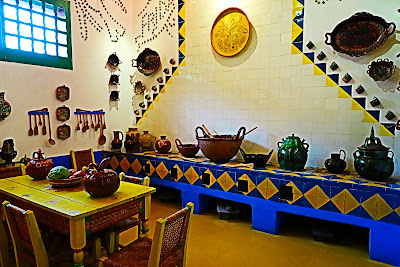Helping me on this tour is Rick Hall. Rick has helped me with a few of my previous tours and he was recently selected by the Mexican Cultural Institute of Artisans to be a judge at all the expositions in the state of Michoacan! He is a perfect choice for this honor for he has worked directly with numerous artisans in central Mexico over the past 45 years and his personal folk art collection is museum quality. Rick's knowledge of the history, artisans, etc., is remarkable!
The first part of the tour starts in Puebla. We will fly directly from Denver to Houston and then on to Puebla.
A city famous for mole poblano, chilies en nogada, excellent dining and Talavera pottery.
The first morning will be a walking tour of the historic center starting in the zolcal0
which is bordered on three sides by the original broad stone arcaded buildings (called portales).
and on the south side is the Cathedral. The Cathedral, considered by many as one of the most beautiful in all of Mexico, was completed in 1648 with bells only in one tower with one bell weighing 8.5 tons.
A visit to the Ex-Convento Santa Rosa, converted into a museum to display crafts produced in the state of Puebla. The above is the former kitchen at the convent constructed with talavera tiles filled with huge caldrons and other earthenware utensils. It is legend that the Dominican nun, Sor Andrea d la Asuncion, created the famous Mole Poblano.
A stop at the Museo Bello with its eclectic collection of over 2,500 pieces of furniture, decorative arts, talavera pottery all collected by Mariano Bello, a 19th century industrialist who owned cigar and textile factories.
One morning we will spend at the International Museum of the Baroque designed by Japanese architect Toyoo Ho. Not only is the exterior architecture breathtaking, the interior exhibitions are some of the best I have seen in a long time.
Dining in Puebla is some of the best. One night we will dine at El Mural de Los Poblano, shown above. And much more...
A visit to the former headquarters of Mexico’s Secretary of Public Education which now houses a muralism museum, including Diego Rivera's first large-scale mural project.
A stop at the Palacio de Correos de Mexico (the central post office) built in 1907 is quite spectacular with its eclectic architectural styles. Pretty amazing.
The Palacio de Iturbide is one of the best colonial, Baroque buildings in the city. Built around 1780, it was once the home of Augustin de Iturbide, the first emperor to Mexico after Mexico's independence from Spain. Later it was a convent, a college and then a hotel before Banamex purchased it. It re-opened as the “Palacio de Cultura Banamex” and today it hosts numerous temporary art exhibitions, as well as art workshops for adults and children. The last exhibition was out of this world, who knows what will be in store for us in June.
A full morning at the Museo Nacional de Antropolgia which houses a world-renowned Pre-Coloumbian collection. The museum’s large, central patio is almost covered by a 275 foot canopy which sits on a 36 foot pillar, the largest concrete structure in the world supported by a single pillar. Now that is what I call a fountain!
The collection in beyond description. Not only is the collection magnificent, the building and gallery spaces are spectacular.
Cena (dinner) at Los Limosneros, a lovely restaurant that puts a contemporary twist on traditional Mexican cuisine. The walls of this old structure date back to 500 years, part of the fortified walls built back in the days.
We will have a relaxing afternoon, touring and dining on one of the colorfully painted trajinera boats
at the floating gardens (Chinampa) in Xochimilco. Xochimilco, meaning “Place of the Flowers” in Nahuatl is famous for its Aztec-made waterways surrounding the ancient city of Tenochtitlan, which is now modern Mexico City.































.JPG)






































